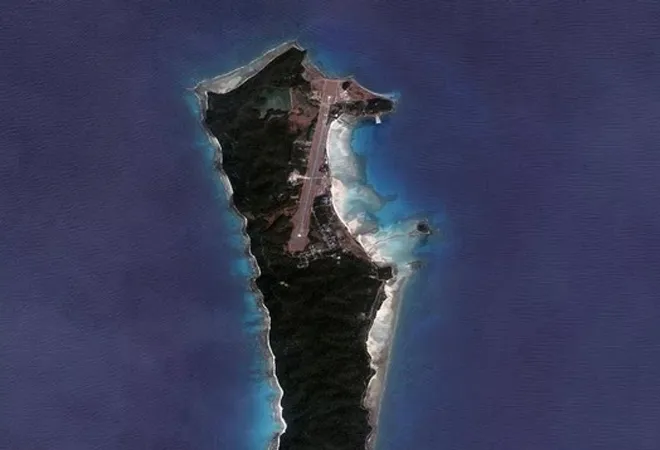
A recent
Chatham House report has brought the Coco Islands in Myanmar into the spotlight and added to the now long-standing deliberation on China’s expanding influence in the Indian Ocean Region (IOR). Located at a mere distance of 55 kilometres from India’s Andaman and Nicobar Islands (ANI), the report cites satellite images that show infrastructure development, including the construction of a causeway connecting the southern tip of the Great Coco Island to a neighbouring island; a pier; a runway; a radar station; and signs of military and aircraft facilities suggesting
a steady makeover. China is reportedly behind these new developments.
While China has, unsurprisingly, denied the allegations of its connection to the Coco Islands and Myanmar too has denied China’s involvement, Beijing is the usual and credible suspect because it is improbable that Myanmar, on its own, has the means as well as the motivation to develop infrastructure on a remote island while the country is in the middle of a protracted civil conflict. The more plausible scenario is that Naypyitaw and Beijing are in it together. China has been a close ally of Myanmar for years and their relationship has only deepened in the aftermath of the military coup in 2021, after which the rest of the world isolated Naypyitaw.
The islands remained relatively underdeveloped due to successive administrations’ preoccupation with handling domestic affairs and civil unrest.
Why are the Coco Islands important?
After Myanmar gained independence in 1948, the Coco Islands, earlier utilised as a naval base by Japanese forces during World War II, became a part of the nation and was used as a penal colony by the military government from 1962 onwards. A naval radar station was established there in the late 20th century. However, the islands remained relatively underdeveloped due to successive administrations’ preoccupation with handling domestic affairs and civil unrest. In recent years, Tatmadaw has demonstrated a keen interest in the strategic significance of the islet with
frequent visits by military chiefs alongside steps to enhance the island’s military capabilities to function as a forward defence outpost and provide early warning advantages.
Theories and speculations about China using the Coco Islands as a signal intelligence (SIGINT) base have been doing the rounds since the early 1990s, which, despite having never been substantiated have nonetheless fuelled apprehensions in the context of China creating footholds across the IOR. The new images show more advanced facilities from what was earlier a
rudimentary radio station, the expansion of a runway from
1,300 to 2,300 meters, and sheds for transport aircraft which bring supplies to the islands. Chinese personnel are also reportedly spotted frequently on the islands where about 150 Myanmar personnel are already posted.
As a neighbouring country, which is politically volatile, subject to international censure and yet in need of financial resources, Myanmar is an ideal candidate for China for furthering its maritime ambitions.
This fresh information has attracted attention and renewed concern because the islands offer a vantage point to Beijing for monitoring, surveilling, and gathering intelligence on maritime movements, particularly India’s naval activities in the IOR and has the capacity to be used as a launchpad for naval deployments.
Why is Myanmar important for China?
For decades, China has sought to diversify its access to maritime routes to secure its maritime supply lines for energy imports and diversify its dependence on the narrow Strait of Malacca. To this end, Beijing has been steadily creating footholds across ports in the IOR from Iran to Africa to Sri Lanka. As a neighbouring country, which is politically volatile, subject to international censure and yet in need of financial resources, Myanmar is an ideal candidate for China for furthering its maritime ambitions. Beijing is also a
major defence supplier, a major trading partner, and the second-largest foreign investor leading several infrastructural projects in the nation such as the China-Myanmar Economic Corridor (CMEC).
Several working committees of CMEC projects have been reorganised to ensure their early completion with most of these projects being implemented along the China-Myanmar border, which is under the influence of ethnic armed groups that maintain
good relations with the Chinese government.
Since the late 1980s, China's main foreign policy objectives in Myanmar have been directed at ensuring stability along its border, protecting its economic interests, and promoting the national reconciliation process. Non-Bamar ethnic armed organisations (EAOs) operating along the China-Myanmar border are not signatories to the Nationwide Ceasefire Agreement, resulting in frequent clashes with the Tatmadaw. These clashes pose a threat to Chinese business interests, as most trade between Myanmar and Yunnan passes through major border towns like Muse. Major economic projects like the China-Myanmar oil and gas pipeline,
Ruili-Mandalay Railways, and
Kyaukphyu Special Economic Zone are located in conflict areas, further highlighting the need for stability. China, thus, has many times been successful in bringing EAOs to the negotiating table with the Junta and has been
alleged as their sponsor. Consequently, China has created a significant stake in Myanmar, which puts it in a useful position to leverage its influence and investments to its own advantage.
Non-Bamar ethnic armed organisations (EAOs) operating along the China-Myanmar border are not signatories to the Nationwide Ceasefire Agreement, resulting in frequent clashes with the Tatmadaw.
Separating facts from fiction
Despite much speculation about China’s presence in the Coco Islands, since the news broke of there being a Chinese SIGINT station in the islands, Myanmar has consistently denied any Chinese military involvement and has even
invited Indian defence officials to visit Great Coco, confirming the presence of an airstrip but no visible Chinese military presence. But if this is true, then it follows that it is the Tatmadaw that is carrying out the developments of its own volition, which does not add up given Myanmar’s unstable internal situation and the lack of any substantial justification for it to be using the Coco Islands from a strategic perspective. On the other hand, given its extensive construction activities on the rocks and islands in the South China Sea and its flurry of activity in and across the IOR, China has substantive interests in backing the Tatmadaw and being involved in these developments.
Nevertheless, regardless of who is behind the developments in the Coco Islands, India must continue to move forward with expanding its own capacities in the ANI because the Coco Islands are in close proximity to the ANI, making developments, particularly military ones in the Islands, of significance to India. New Delhi has, therefore, pushed for upgrading the deterrence capabilities of the
tri-service AN Command in anticipation that air defence and air surveillance would follow the infrastructural developments taking place in the Coco Islands.
Pratnashree Basu is an Associate Fellow at the Centre for New Economic Diplomacy, Observer Research Foundation.
Sreeparna Banerjee is a Junior Fellow of the Strategic Studies Programme, Observer Research Foundation.
The views expressed above belong to the author(s). ORF research and analyses now available on Telegram! Click here to access our curated content — blogs, longforms and interviews.



 A recent
A recent  PREV
PREV



